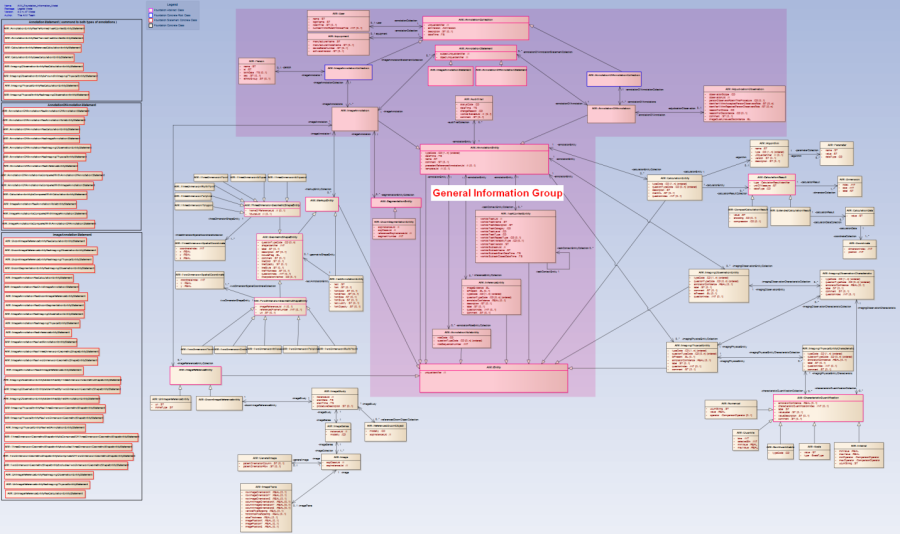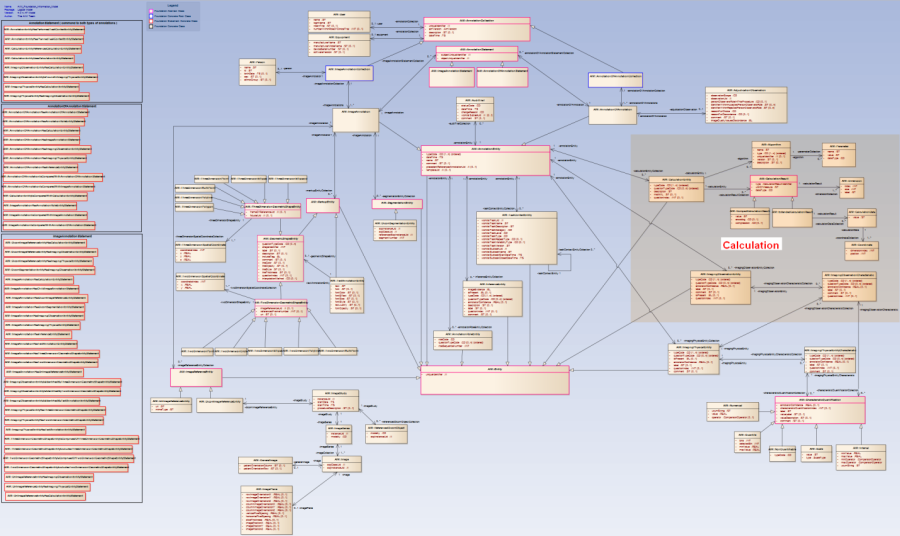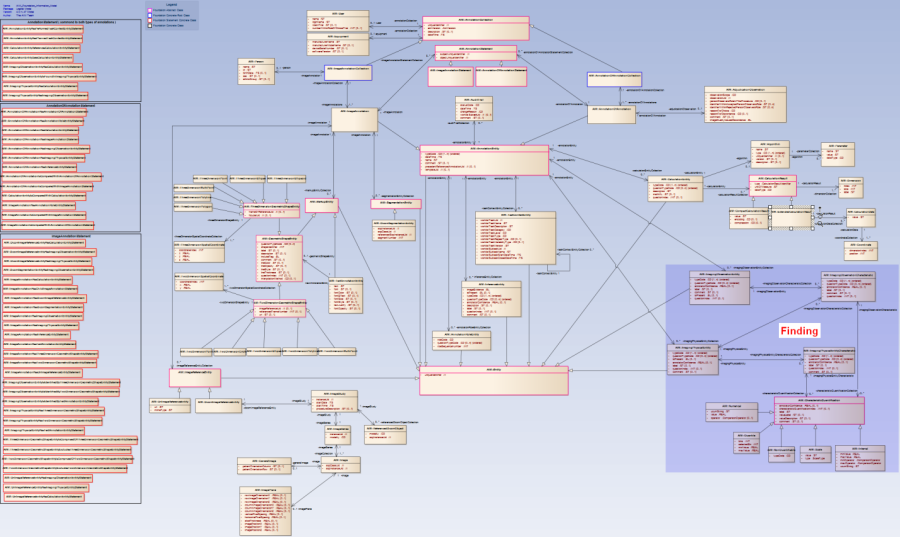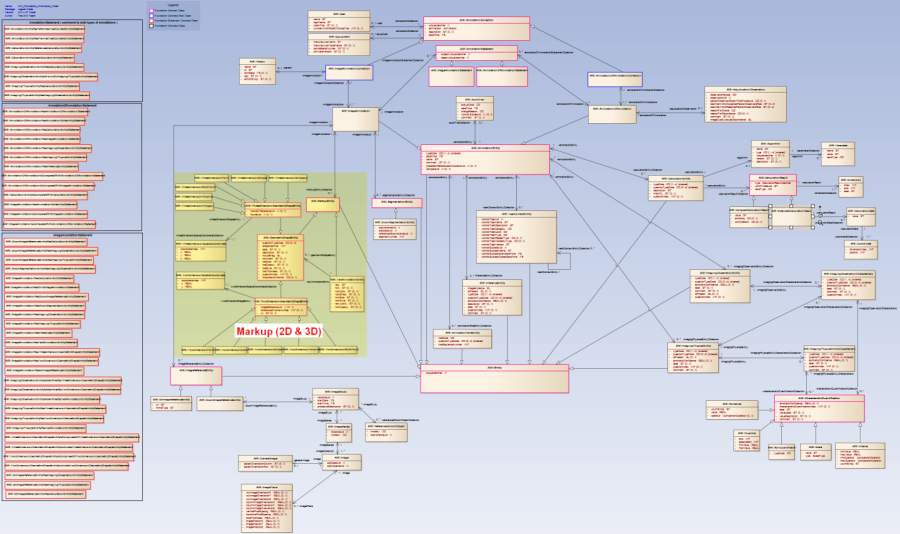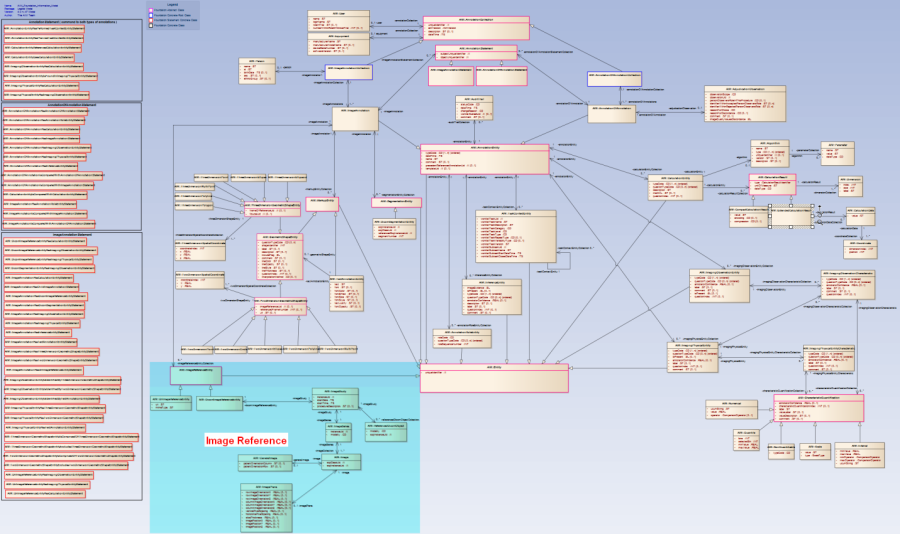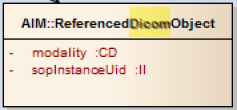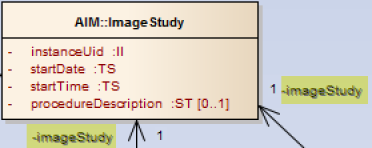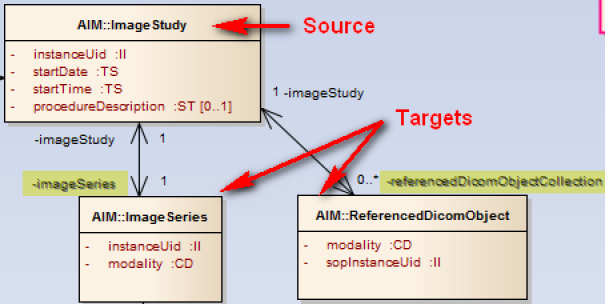 |
Page History
...
The next class that we should examine is AnnotationEntity class. It is an abstract base class for the ImageAnnotation and AnnotationOfAnnotation classes. The AnnotationEntity class captures name, a general description of the AIM annotation, type of annotation via controlled terminology, creation date and time, a reference to the AIM template used to create an annotation, a reference to a previously related AIM annotation, and AIM annotation UID.
The ImageAnnotation class annotates images. The AnnotationOfAnnotation class annotates other AIM annotations for comparison and reference purposes. Both ImageAnnotation and AnnotationOfAnnotation have AnnotationRoleEntity, AuditTrail, InferenceEntity and TaskContextEntity classes. The ImageAnnotation associates with an abstract class SegmentationEntity. The model currently supports DICOM Segmentation via DicomSegmentationEntity. DICOM Segmentations are either binary or fractional. The DicomSegmentationEntity class represents a multi-frame image representing a classification of pixels in one or more referenced images. The class contains the DICOM SOP class UID that defines the type of segmentation. It references its own instance UID and the instance UID of the image to which the segmentation is applied. It also has an identification number for the segment that shall be unique within the segmentation instance in which it is created. An ImageAnnotation may have zero or more segmentation objects. The AnnotationRoleEntity describes a role of an annotation. Each instance can have a role associated with it, e.g. a baseline case. The InferenceEntity class provides a conclusion derived through interpreting an imaging study and/or medical history. The AuditTrail class captures the status of an annotation instance using a coded term, contains identifying and descriptive attributes of the reading session, and the reading subtask that results in clinical environment or trial findings. The class consists of the overall task and the specific subtask. A task represents a unit of overall work. It may have one or more subtasks.
Figure 5. General Information Group
The Calculation group, shown in Figure 6, represents the calculation results of an AIM annotation. Calculation results may or may not be directly associated with graphical symbols or markups. For example, given an image with a single ellipse markup, calculation results can be an area in square millimeters and references maximum and minimum pixel values. As another example, an image has an arrow pointing to a specific location and two concentric circles, with an area measurement of the larger circle minus the smaller circle. The computation result is based on the independence calculation made on each circle. The AIM schema allows calculation results that are not directly related to markups. CalculationEntity class has overall information about a calculation performed related directly to image or images. It defines a type of calculation, such as area, height, radius, and volume of ellipsoid from UCUM, and takes the form of controlled terminology that can be captured in code value, code meaning, and coding scheme designator in a single attributed call, typeCode. It also captures MathML as a string attribute within the class. A questionTypeCode attribute captures a reason why a calculation is needed as code. A textual description can be stored in the description attribute. The CalculationResult abstract class contains the type of result (e.g. binary, scalar, vector, histogram, array, histogram, or matrix), unit of measurement, and coded data type (a primitive programming data type such as integer, double, etc. as well as other data type such as URI). A CalculationResult can be stored as a compact or an extended result, CompactCalculationResult and ExtendedCalculation result, respectively. CompactCalculationResult has three attributes: value, encoding, and compression. The result of a calculation is captured in a string format in a value attribute that can hold a value of array, binary, histogram, matrix, scalar, and vector. Encoding is an encoding method applied to the content of the value attribute. Compression is a method used to compress the content in value attribute. CalculationResult has an association with the Dimension class that states how many dimensions a CalculationResult has. ExtendedCalculation stores a result of a calculation individually with the precise location of each element in the result. The Data class is used to store the result value. The Coordinate class identifies location within a dimension for the Data class. A CalculationEntity may have a relationship with a markup or a collection of markups, other calculations, imaging observation, and imaging physical entity. These types of relationships can be captured as AIM statements.
Figure 6. Calculation Group
The classes in the Image Semantic Content group, shown in Figure 7, are used to gather image findings or interpretations of images. The ImagingPhysicalEntity class stores an anatomical location (e.g. femur) as a coded term from a recognized controlled vocabulary (RadLex, SNOMED-CT, UMLS, etc). The ImagingPhysicalEntityCharacteristic class further describes the ImagingPhysicalEntity class such as "fracture". The ImagingObservationEntity class is the description of things that are seen in an image. "Mass," "Radiographic evidence of pleural effusion," "Foreign Body," and Artifact," are all examples of ImagingObservationEntity. The ImagingObservationEntityCharacteristic class includes descriptors of the ImagingObservationEntity class such as "dense," "heterogeneous," "hypoechoic," and "spiculated". Both ImagingPhysicalEntityCharacteristic and ImagingObservationEntityCharacteristic may be associated with CharacteristicQuantification. A quantification can be a numerical value, an interval (e.g. 34-67%), a scale (e.g. 1:None, 2:Mild), a quantile (e.g. 1(1-50), 2(51-100)), and a non-quantifiable (e.g. none, mild, mark).
Figure 7. Image Semantic Content Group (Finding)
...
The TextAnnotationEntity class has coordinates captured as SCOORD or SCOORD3D graphic type as TwoDimensionMultiPoint or ThreeDimensionMultiPoint, respectively. A TextAnnotationEntity's MultiPoint implementation is expected to have no more than two coordinates that can be represented as an arrow connecting TextAnnotationEntity to a point on an image. Only the ImageAnnotation class can have markups.
Figure 8. Markup Group
The ImageReference group, as shown in Figure 9, represents an image or collection of images being annotated. The two possible types of references are DICOM and URI or web image reference. First, DICOMImageReferenceEntity associates with other classes that mimic the DICOM information model. It has one ImageStudy object that has one ImageSeries object, which in turn has one or more Image objects. The ImageStudy class has study instance UID, start date and start time, and procedure description. ImageStudy may have zero or more references to DICOM objects via the ReferencedDicomObject class. The ImageSeries class has series instance UID. The Image class has SOP class UID and SOP instance UID. The Image class has two associations with GeneralImage and ImagePlane; both classes came from the DICOM module general image and image plane, respectively. They are used to store frequently-used DICOM tags such as patient orientation, pixel spacing, and image position. The second image reference type is WebImageReference that contains a URI to an image.
Figure 9. ImageReference Group
...
- Naming Convention:
- A name of a class must explicitly describe what information the class will collect. It must start with a capital letter. If part of the class name has a capital abbreviation, only the first character of the abbreviation is capitalized, e.g. DICOM should be Dicom see figure 10.
Figure 10. A Class Name
Association name, figure 11, of a source class has the same name as the source class name with the first character being a lower case.
Figure 11. An Association Name of a Source Class
Association name of a target class, figure 12, has the same name as the target class name with the first character being a lower case.
Figure 12. An Association Name of a Target Class
...
